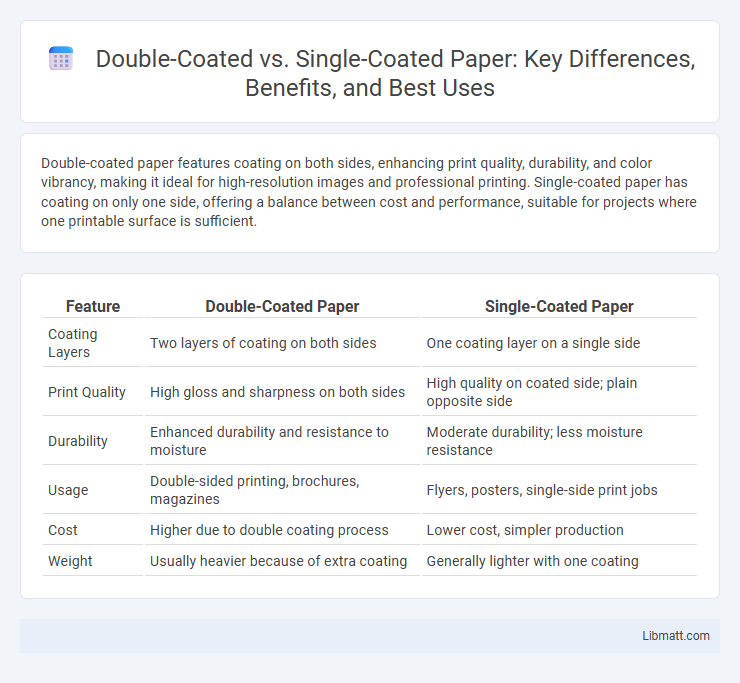Double-coated paper features coating on both sides, enhancing print quality, durability, and color vibrancy, making it ideal for high-resolution images and professional printing. Single-coated paper has coating on only one side, offering a balance between cost and performance, suitable for projects where one printable surface is sufficient.
Table of Comparison
| Feature | Double-Coated Paper | Single-Coated Paper |
|---|---|---|
| Coating Layers | Two layers of coating on both sides | One coating layer on a single side |
| Print Quality | High gloss and sharpness on both sides | High quality on coated side; plain opposite side |
| Durability | Enhanced durability and resistance to moisture | Moderate durability; less moisture resistance |
| Usage | Double-sided printing, brochures, magazines | Flyers, posters, single-side print jobs |
| Cost | Higher due to double coating process | Lower cost, simpler production |
| Weight | Usually heavier because of extra coating | Generally lighter with one coating |
Introduction to Paper Coating Types
Double-coated paper features two layers of coating on both sides, enhancing smoothness, brightness, and printability, making it ideal for high-quality graphic printing. Single-coated paper has a coating on only one side, offering a balance between cost and performance, often used for printing on one side while the other remains uncoated for better handling or writing. Understanding these paper coating types helps you select the best option for your printing needs, whether for professional presentations or everyday documents.
What is Double-Coated Paper?
Double-coated paper features two layers of coating, one on each side, enhancing its smoothness, brightness, and printability compared to single-coated paper that has coating on only one side. This double coating improves ink holdout, sharp image reproduction, and reduces ink absorption, making it ideal for high-quality printing tasks such as magazines, brochures, and high-end catalogs. Your choice of double-coated paper ensures superior visual clarity and durability in printed materials.
What is Single-Coated Paper?
Single-coated paper features a coating on only one side, enhancing print quality and surface smoothness for that side while keeping the other side uncoated and more porous. This type of paper is ideal for applications where only one side requires high-resolution printing or a glossy finish, such as brochures, posters, or labels. Your choice of single-coated paper can improve ink adhesion and color vibrancy on the coated side while reducing costs compared to double-coated options.
Key Differences Between Double-Coated and Single-Coated Paper
Double-coated paper has a coating on both sides, enhancing print quality, durability, and ink holdout, whereas single-coated paper features a coating on only one side, typically the front, providing a smooth surface for printing but less overall protection. Double-coated options are ideal for high-end printing and photo applications requiring sharp images on both sides, while single-coated paper suits general printing needs where only one side is to be printed. Your choice depends on the specific printing requirements, budget, and the desired balance between quality and cost-effectiveness.
Advantages of Double-Coated Paper
Double-coated paper offers superior print quality with enhanced gloss, sharpness, and color vibrancy due to its coating on both sides, making it ideal for high-end magazines and brochures. The dual coatings improve opacity and reduce show-through, resulting in better readability and professional appearance. Its enhanced durability and resistance to ink bleed provide consistent performance in high-speed printing environments.
Benefits of Single-Coated Paper
Single-coated paper offers enhanced print quality on the coated side, providing a smooth, glossy finish ideal for high-resolution images and vibrant color reproduction. It is more cost-effective compared to double-coated paper, making it suitable for budget-conscious projects while still delivering professional results. Additionally, single-coated paper is easier to cut and fold, improving productivity in packaging and printing applications.
Common Applications for Double-Coated Paper
Double-coated paper is commonly used in high-quality printing applications such as magazines, brochures, and catalogs due to its superior smoothness and enhanced ink holdout, which produces vibrant images and sharp text. It is preferred for photographic prints and high-end advertising materials where color accuracy and detail are critical. Single-coated paper, while economical, lacks the refined surface needed for the most demanding graphic and photographic uses found in double-coated alternatives.
Best Uses for Single-Coated Paper
Single-coated paper is best used for applications where one smooth, coated surface is needed to enhance print quality while maintaining a natural, uncoated feel on the reverse side. It is ideal for book covers, magazine covers, and marketing materials where durability and vibrant image reproduction are important but cost-effectiveness is desired. Your projects requiring a balance between print clarity and texture benefit significantly from single-coated paper's unique properties.
How to Choose the Right Paper Coating
Choosing the right paper coating depends on the intended use and desired finish quality of the printed material. Double-coated paper provides a smoother, glossier surface ideal for high-resolution images and vibrant color reproduction, making it perfect for magazines and high-end brochures. Single-coated paper offers a cost-effective solution with adequate print clarity for everyday uses such as flyers or newspapers, balancing print quality and budget considerations.
Environmental Impact of Double-Coated vs Single-Coated Paper
Double-coated paper typically involves more intensive manufacturing processes, leading to higher energy consumption and increased carbon emissions compared to single-coated paper. Single-coated paper uses fewer chemical coatings, making it more biodegradable and easier to recycle, which reduces its environmental footprint. Your choice of single-coated paper supports sustainable printing by minimizing waste and promoting eco-friendly production.
Double-coated vs single-coated paper Infographic

 libmatt.com
libmatt.com